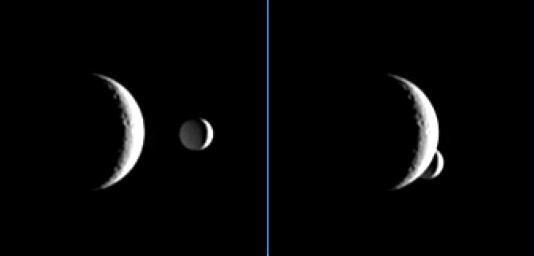
|
Now You See Me…
- Click the image above for a larger view
- Full-Res JPEG (336 x 161) (3.3 kB)
- Full-Res TIFF (336 x 161) (55.9 kB)
Caption:
Enceladus briefly passes behind the crescent of Rhea in these images, which are part of a "mutual event" sequence taken by Cassini. These sequences help scientists refine our understanding of the orbits of Saturn's moons.
The images were taken one minute apart as smaller Enceladus (505 kilometers, or 314 miles across) darted behind Rhea (1,528 kilometers, or 949 miles across) as seen from the Cassini spacecraft's point of view.
The images were taken in visible light with the Cassini spacecraft narrow-angle camera on April 14, 2006, at a distance of approximately 3.4 million kilometers (2.1 million miles) from Rhea and 4.1 million kilometers (2.5 million miles) from Enceladus. The image scale is 20 kilometers (13 miles) per pixel on Rhea and 24 kilometers (15 miles) per pixel on Enceladus.
Background Info:
The Cassini-Huygens mission is a cooperative project of NASA, the European Space Agency and the Italian Space Agency. The Jet Propulsion Laboratory, a division of the California Institute of Technology in Pasadena, manages the mission for NASA's Science Mission Directorate, Washington, D.C. The Cassini orbiter and its two onboard cameras were designed, developed and assembled at JPL. The imaging operations center is based at the Space Science Institute in Boulder, Colo.
For more information about the Cassini-Huygens mission visit http://saturn.jpl.nasa.gov/home/index.cfm . The Cassini imaging team homepage is at http://ciclops.org .
Cataloging Keywords:
| Name | Value | Additional Values |
|---|---|---|
| Target | Rhea | Enceladus |
| System | Saturn | |
| Target Type | Satellite | |
| Mission | Cassini-Huygens | |
| Instrument Host | Cassini Orbiter | |
| Host Type | Orbiter | |
| Instrument | Imaging Science Subsystem (ISS) | |
| Detector | Narrow Angle Camera | |
| Extra Keywords | Color, Visual | |
| Acquisition Date | ||
| Release Date | 2006-05-18 | |
| Date in Caption | 2006-04-14 | |
| Image Credit | NASA/JPL/Space Science Institute | |
| Source | photojournal.jpl.nasa.gov/catalog/PIA08180 | |
| Identifier | PIA08180 | |
